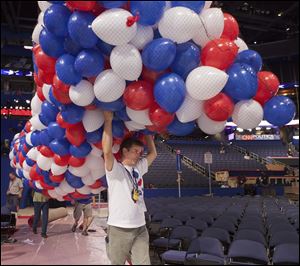
Balloons add pop to conventions
Carefully crafted political pandemonium can still go awry
8/30/2012
Balloons are carried across the convention floor as preparations continue for the Republican National Convention in Tampa last week.
TAMPA -- Republicans and Democrats love balloon drops at their national conventions.
Thousands of balloons, red, white, and blue balloons, filled with air, tumble down from the rafters. The band blares away, the delegates and visitors whoop with joy. It's pandemonium, carefully calculated to show that happy days are here again, even when the wise men behind the scenes worry their candidate doesn't stand a chance.
Balloon drops are tricky; balloons don't always drop the way they should. Jimmy Carter's balloons at his convention in New York's Madison Square Garden in 1980 came drifting down, slowly, one by one. A weak balloon drop, it has been whispered ever since, foreshadows a weak, maybe a losing, campaign. (It was at this same convention that Mr. Carter delivered a tribute to Hubert Horatio Humphrey, who had died two years earlier. He called him Hubert Horatio Hornblower, mixing up the former vice president with C.S. Forester's fictional Royal Navy hero in Napoleonic times, Horatio Hornblower. When things go bad at conventions, they tend to go really bad. Mr. Carter was trounced by Ronald Reagan.
The balloons at tonight's Republican convention will be blown up (mechanically, of course, not by human lung power) by students from nearby Gaither High School. They are to tumble down from the rafters as the ticket, Mitt Romney and Paul Ryan, take the stage.
RELATED CONTENT:
One of the legendary balloon stories (it might even be true) emerged from the Republican convention in Miami Beach in 1972. Someone dreamed up the idea of a balloon "lift" -- in which balloons would be filled with helium and let loose from the floor of the convention hall and ascend to the rafters.
Then these same geniuses began to wonder, what if these balloons ran out of helium and began drifting down to the podium before the big balloon drop, maybe even blocking Richard Nixon's face from the TV cameras as he was making his acceptance speech.
That terrible possibility became a probability in a rehearsal when balloons filled with helium were released hours before the session of the convention convened. Most of them did, in fact, run out of helium and begin drifting down toward the podium, but a few remained up there in the rafters, causing something of a balloon panic.
That was solved when an enterprising soul turned up with a BB gun and began blasting away at the offending balloons. Problem solved.
The balloon drop at the 1988 Republican convention in the New Orleans Superdome was a bit of a calamity too. Some of the balloons dropped behind the podium, not far from big lights that were being used to illuminate the podium's backdrop. They began popping and a few of them even caught fire.
It was a problem, briefly, but not nearly as big a problem in the long run as George Bush's invitation to read his lips, "No new taxes."
But the best balloon story of all comes from the Democratic convention at what was then the FleetCenter in Boston in 2004 that nominated John Kerry for president and John Edwards for vice president.
The director/producer for the convention was Don Mischer, an award-winning professional at this sort of thing. Mr. Mischer watched with riveting interest as the balloons began to drop, and didn't like what he was seeing.
He began shouting through his mic at the technicians up in the rafters who were in charge, little knowing that he was going live on CNN. "Balloons, balloons!" he barked. "There's not enough coming down. Why the hell is nothing falling?" And then he used an obscenity. "What the ... are you guys doing up there? We want more balloons coming down. More balloons! More balloons!"
"We may have heard a profanity," Wolf Blitzer said.
The Block News Alliance consists of The Blade and the Pittsburgh Post-Gazette.
James M. Perry, chief political correspondent of the Wall Street Journal until his retirement, will be contributing regular observations as part of The Block News Alliance's Early Returns blog coverage during the two political conventions.